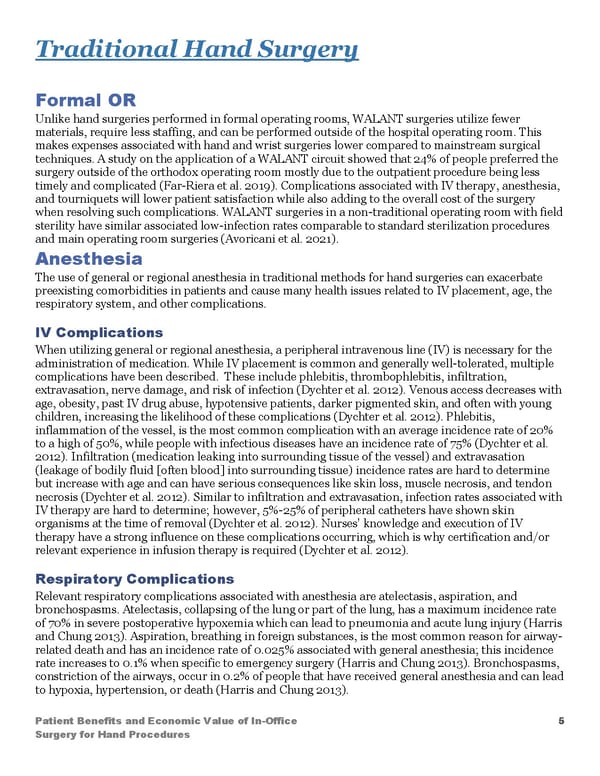Traditional Hand Surgery Formal OR Unlike hand surgeries performed in formal operating rooms, WALANT surgeries utilize fewer materials, require less staffing, and can be performed outside of the hospital operating room. This makes expenses associated with hand and wrist surgeries lower compared to mainstream surgical techniques. A study on the application of a WALANT circuit showed that 24% of people preferred the surgery outside of the orthodox operating room mostly due to the outpatient procedure being less timely and complicated (Far-Riera et al. 2019). Complications associated with IV therapy, anesthesia, and tourniquets will lower patient satisfaction while also adding to the overall cost of the surgery when resolving such complications. WALANT surgeries in a non-traditional operating room with field sterility have similar associated low-infection rates comparable to standard sterilization procedures and main operating room surgeries (Avoricani et al. 2021). Anesthesia The use of general or regional anesthesia in traditional methods for hand surgeries can exacerbate preexisting comorbidities in patients and cause many health issues related to IV placement, age, the respiratory system, and other complications. IV Complications When utilizing general or regional anesthesia, a peripheral intravenous line (IV) is necessary for the administration of medication. While IV placement is common and generally well-tolerated, multiple complications have been described. These include phlebitis, thrombophlebitis, infiltration, extravasation, nerve damage, and risk of infection (Dychter et al. 2012). Venous access decreases with age, obesity, past IV drug abuse, hypotensive patients, darker pigmented skin, and often with young children, increasing the likelihood of these complications (Dychter et al. 2012). Phlebitis, inflammation of the vessel, is the most common complication with an average incidence rate of 20% to a high of 50%, while people with infectious diseases have an incidence rate of 75% (Dychter et al. 2012). Infiltration (medication leaking into surrounding tissue of the vessel) and extravasation (leakage of bodily fluid [often blood] into surrounding tissue) incidence rates are hard to determine but increase with age and can have serious consequences like skin loss, muscle necrosis, and tendon necrosis (Dychter et al. 2012). Similar to infiltration and extravasation, infection rates associated with IV therapy are hard to determine; however, 5%-25% of peripheral catheters have shown skin organisms at the time of removal (Dychter et al. 2012). Nurses’ knowledge and execution of IV therapy have a strong influence on these complications occurring, which is why certification and/or relevant experience in infusion therapy is required (Dychter et al. 2012). Respiratory Complications Relevant respiratory complications associated with anesthesia are atelectasis, aspiration, and bronchospasms. Atelectasis, collapsing of the lung or part of the lung, has a maximum incidence rate of 70% in severe postoperative hypoxemia which can lead to pneumonia and acute lung injury (Harris and Chung 2013). Aspiration, breathing in foreign substances, is the most common reason for airway- related death and has an incidence rate of 0.025% associated with general anesthesia; this incidence rate increases to 0.1% when specific to emergency surgery (Harris and Chung 2013). Bronchospasms, constriction of the airways, occur in 0.2% of people that have received general anesthesia and can lead to hypoxia, hypertension, or death (Harris and Chung 2013). Patient Benefits and Economic Value of In-Office 5 Surgery for Hand Procedures
 Patient Benefits and Economic Value of InOffice Surgery for Hand Procedures Page 4 Page 6
Patient Benefits and Economic Value of InOffice Surgery for Hand Procedures Page 4 Page 6